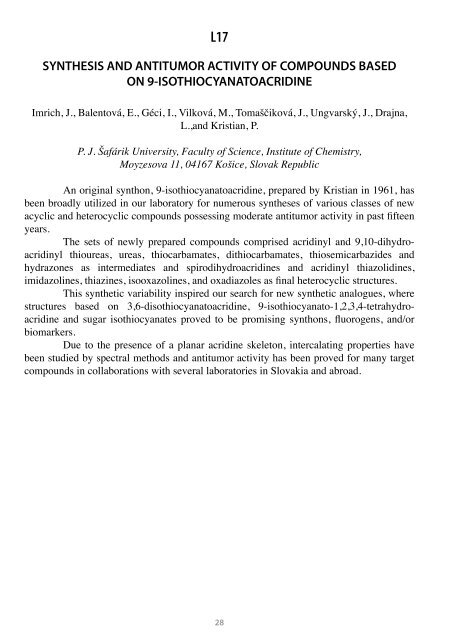Cancer Research Institute, Slovak Academy of Sciences
Cancer Research Institute, Slovak Academy of Sciences
Cancer Research Institute, Slovak Academy of Sciences
You also want an ePaper? Increase the reach of your titles
YUMPU automatically turns print PDFs into web optimized ePapers that Google loves.
L17<br />
SYNTHESIS AND ANTITUMOR ACTIVITY OF COMPOUNDS BASED<br />
ON 9-ISOTHIOCYANATOACRIDINE<br />
Imrich, J., Balentová, E., Géci, I., Vilková, M., Tomaščiková, J., Ungvarský, J., Drajna,<br />
L.,and Kristian, P.<br />
P. J. Šafárik University, Faculty <strong>of</strong> Science, <strong>Institute</strong> <strong>of</strong> Chemistry,<br />
Moyzesova 11, 04167 Košice, <strong>Slovak</strong> Republic<br />
An original synthon, 9-isothiocyanatoacridine, prepared by Kristian in 1961, has<br />
been broadly utilized in our laboratory for numerous syntheses <strong>of</strong> various classes <strong>of</strong> new<br />
acyclic and heterocyclic compounds possessing moderate antitumor activity in past fifteen<br />
years.<br />
The sets <strong>of</strong> newly prepared compounds comprised acridinyl and 9,10-dihydroacridinyl<br />
thioureas, ureas, thiocarbamates, dithiocarbamates, thiosemicarbazides and<br />
hydrazones as intermediates and spirodihydroacridines and acridinyl thiazolidines,<br />
imidazolines, thiazines, isooxazolines, and oxadiazoles as final heterocyclic structures.<br />
This synthetic variability inspired our search for new synthetic analogues, where<br />
structures based on 3,6-disothiocyanatoacridine, 9-isothiocyanato-1,2,3,4-tetrahydro-<br />
acridine and sugar isothiocyanates proved to be promising synthons, fluorogens, and/or<br />
biomarkers.<br />
Due to the presence <strong>of</strong> a planar acridine skeleton, intercalating properties have<br />
been studied by spectral methods and antitumor activity has been proved for many target<br />
compounds in collaborations with several laboratories in <strong>Slovak</strong>ia and abroad.<br />
L18<br />
COMPUTER-ASSISTED COMBINATORIAL DRUG DESIGN<br />
Frecer, V.<br />
<strong>Cancer</strong> <strong>Research</strong> <strong>Institute</strong>, <strong>Slovak</strong> <strong>Academy</strong> <strong>of</strong> <strong>Sciences</strong>, SK-83391 Bratislava, <strong>Slovak</strong>ia<br />
vladimir.frecer@savba.sk<br />
The last decades has witnessed a technological revolution in molecular design,<br />
material science and nanotechnology. Combinatorial chemistry, parallel synthesis and<br />
high-throughput screening as well as computational design techniques have been embraced<br />
by numerous industry sectors as the means to accelerate the discovery <strong>of</strong> new molecules<br />
and materials with the desired properties. The central aim <strong>of</strong> the computer-assisted molecular<br />
and material design techniques is to help the scientists to make the discovery process<br />
faster, cheaper and safer and consequently to foster the industrial research and innovation.<br />
We now have the complete genome sequences <strong>of</strong> more than 100 organisms and<br />
can employ the tools <strong>of</strong> bioinformatics to identify genes and proteins as potential drug<br />
targets. The breadth <strong>of</strong> innovative techniques ranging from fragment-based, analog-based,<br />
structure-based and combinatorial library design allows us to design, synthesize, or screen<br />
for molecules acting on the chosen drug targets more efficiently.<br />
Principles and selected examples <strong>of</strong> the use <strong>of</strong> computer-assisted combinatorial<br />
design techniques in the pharmaceutical industry will be presented and discussed. Virtual<br />
library design, focusing, virtual screening as well as pharmacokinetic properties prediction,<br />
will be illustrated on an example <strong>of</strong> analog-based design <strong>of</strong> antiviral compounds.<br />
28 29


